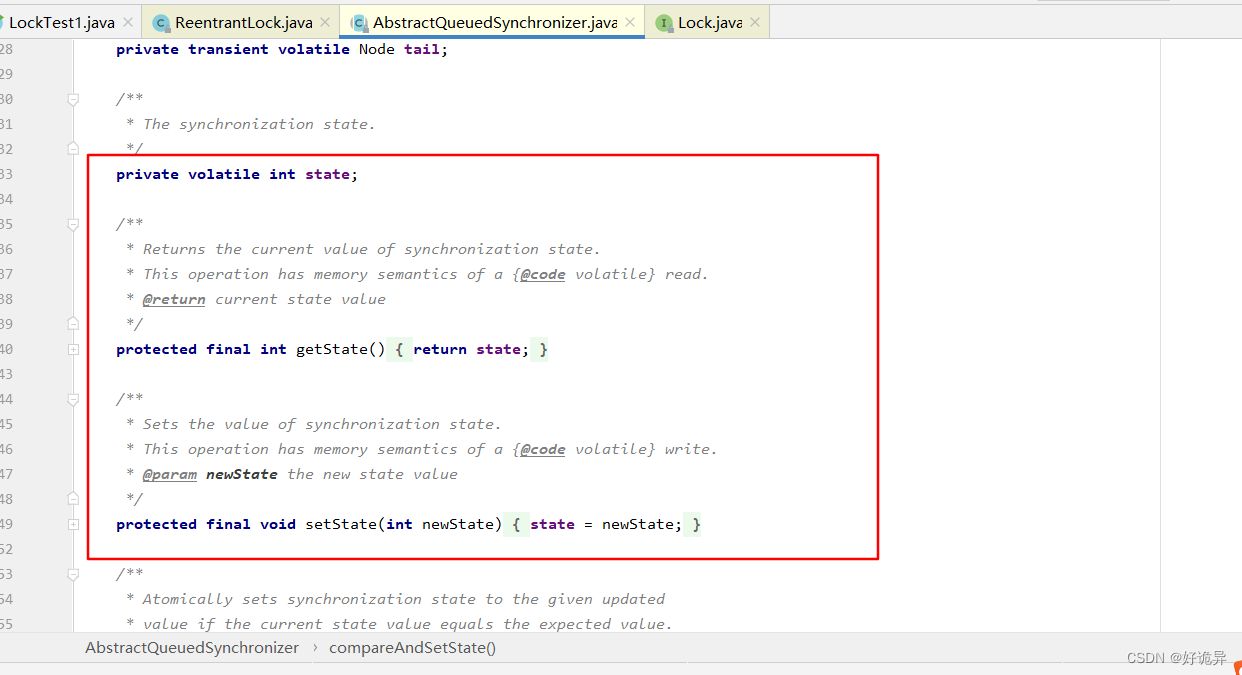了解前提知识:
ReentrantLock是基于AQS实现的独占锁,即同一时刻只能被一个线程占用;此外还有共享锁,例:CountDownLatch和Semaphore等。
核心状态位:在AQS中维护了一个volatile修饰的变量state,用来标记锁的状态

AQS实现独占锁实在内部类NODE中定义的,源码如下所示
static final class Node {
/** Marker to indicate a node is waiting in shared mode */
static final Node SHARED = new Node();
/** Marker to indicate a node is waiting in exclusive mode */
static final Node EXCLUSIVE = null;
static final int PROPAGATE = -3;
volatile int waitStatus;
volatile Node prev;
volatile Node next;
volatile Thread thread;
Node nextWaiter;
final boolean isShared() {
return nextWaiter == SHARED;
}
final Node predecessor() throws NullPointerException {
Node p = prev;
if (p == null)
throw new NullPointerException();
else
return p;
}
Node() { // Used to establish initial head or SHARED marker
}
Node(Thread thread, Node mode) { // Used by addWaiter
this.nextWaiter = mode;
this.thread = thread;
}
Node(Thread thread, int waitStatus) { // Used by Condition
this.waitStatus = waitStatus;
this.thread = thread;
}
}
通过代码得知该NODE是一个双向列表,链表每个节点都存在上节点prev和下节点next,每个节点都保存了当前状态waitStatus和当前线程Thread,在node中通过SHARED和EXCLUSIVE表示共享和独占
static final Node SHARED = new Node();
static final Node EXCLUSIVE = null;
NODE类中定义了4个常量
/** 表示当前节点的线程被取消 */
static final int CANCELLED = 1;
/** 表示后继节点中的线程处于等待状态,需要被唤醒 */
static final int SIGNAL = -1;
/** 表示当前节点中的线程在等待某个条件,也就是当前节点处于condition队列中*/
static final int CONDITION = -2;
/**表示当前场景下能够执行后续的acquireShared操作*/
static final int PROPAGATE = -3;
开始源码解析:
ReentrantLock 可以实现公平锁和非公平锁,他默认实现是非公平锁,ReentrantLock 中公平锁和非公平的体现在哪呢,我们等下来说,现在开始研究非公平锁,这个会了,公平锁也就会了。
//创建一个ReentrantLock
ReentrantLock lock = new ReentrantLock();
//点击进去看构造方法 见名知意
public ReentrantLock() {
sync = new NonfairSync();
}
//也可以通过传参决定是不是公平锁了
public ReentrantLock(boolean fair) {
sync = fair ? new FairSync() : new NonfairSync();
}
先来看一下怎么使用。接下来,我们以这段代码作为研究对象,开始深入解析源码实现的过程
public static void main(String[] args) {
ReentrantLock lock = new ReentrantLock();
System.out.println(Thread.currentThread().getName()+"开始获取锁");
lock.lock();
System.out.println(Thread.currentThread().getName()+"获取锁成功");
try {
Thread.sleep(1000);
} catch (InterruptedException e) {
e.printStackTrace();
}
new Thread(new Runnable() {
@Override
public void run() {
System.out.println(Thread.currentThread().getName()+"开始获取锁");
lock.lock();
System.out.println(Thread.currentThread().getName()+"获取锁成功");
}
},"t1").start();
new Thread(new Runnable() {
@Override
public void run() {
System.out.println(Thread.currentThread().getName()+"开始获取锁");
lock.lock();
System.out.println(Thread.currentThread().getName()+"获取锁成功");
}
},"t2").start();
}
}

首先看一下类图,最终实现是基于我们所说的aqs

1、lock()方法
点击找到lock的实现方法,第一次进来的时候通过CAS将state从0改为1,如果修改成功那么则用一个变量记录当前线程setExclusiveOwnerThread(Thread.currentThread()); 点进去就看见了exclusiveOwnerThread = thread;,我们的main线程肯定会走这个if的,t1,t2则会进入到else里面。修改成功说明当前线程获取到锁了,其他线程则会进入阻塞等待中,我们主要就来研究被阻塞的t1和t2。
final void lock() {
if (compareAndSetState(0, 1))
setExclusiveOwnerThread(Thread.currentThread());
else
acquire(1);
}
2、acquire(1);
acquire(1)的实现如下。这里可以再将该方法拆解成三步
public final void acquire(int arg) {
if (!tryAcquire(arg) &&
acquireQueued(addWaiter(Node.EXCLUSIVE), arg))
selfInterrupt();
}
2.1、tryAcquire(arg)
找到tryAcquire(arg)的实现源码,state值被main线程修改为1了 所以第一个判断不会进来了,在上面修改成功之后有这样一步处理setExclusiveOwnerThread(Thread.currentThread()); 所以这个 getExclusiveOwnerThread()==main 所以也不会进入判断,因此这个方法的代码最终结果返回false,!tryAcquire(arg)==true 程序继续执行。
final boolean nonfairTryAcquire(int acquires) {
final Thread current = Thread.currentThread();
int c = getState();
if (c == 0) {
if (compareAndSetState(0, acquires)) {
setExclusiveOwnerThread(current);
return true;
}
}
else if (current == getExclusiveOwnerThread()) {
int nextc = c + acquires;
if (nextc < 0) // overflow
throw new Error("Maximum lock count exceeded");
setState(nextc);
return true;
}
return false;
}
2.2、addWaiter(Node.EXCLUSIVE)
我们要先有这样一个概念,在aqs当中会有一个双向链表来存放阻塞中的线程,在这个双线链表中,有头节点和尾结点,也就是Node prev;Node next;都是默认为null的。再继续看下面的代码。代码中static final Node EXCLUSIVE = null;也就是创建了一个空节点。将node节点中的Thread设置为当前线程,当t1先过来的时候,由于头结点和尾结点都是null 所以会走 enq(node);
private Node addWaiter(Node mode) {
Node node = new Node(Thread.currentThread(), mode);
// Try the fast path of enq; backup to full enq on failure
Node pred = tail;
if (pred != null) {
node.prev = pred;
if (compareAndSetTail(pred, node)) {
pred.next = node;
return node;
}
}
enq(node);
return node;
}
重点来看一下 enq(final Node node)方法, 这里是个循环。也就是t1会进来,进行链表的一些初始化。
第一次循环的时候tail肯定为null所以会new Node() 并将该对象赋值给头结点和尾结点,接着进行下一次循环,第二次循环的时候由于尾结点不为null了,所以直接将传入进来的node节点的前节点设置为旧尾节点,然后将node节点修改为尾结点。这段代码的逻辑就是初始化链表,在链表上追加数据,将node节点放在最后面,修改尾结点指向。再回到上面代码,当t2过来的时候由于Node pred = tail !=null了,所以可以直接将该node节点放入到链表尾部。当这些代码执行完毕之后返回node节点。Node addWaiter(Node mode)的返回结果就是当前链表的尾结点
private Node enq(final Node node) {
for (;;) {
Node t = tail;
if (t == null) { // Must initialize
if (compareAndSetHead(new Node()))
tail = head;
} else {
node.prev = t;
if (compareAndSetTail(t, node)) {
t.next = node;
return t;
}
}
}
}
2.3、 acquireQueued(addWaiter(Node.EXCLUSIVE), arg)
点进去看看源码先.上面说了,最后会返回尾部节点,这里的参数也就是尾部节点
final boolean acquireQueued(final Node node, int arg) {
boolean failed = true;
try {
boolean interrupted = false;
for (;;) {
final Node p = node.predecessor();
if (p == head && tryAcquire(arg)) {
setHead(node);
p.next = null; // help GC
failed = false;
return interrupted;
}
if (shouldParkAfterFailedAcquire(p, node) &&
parkAndCheckInterrupt())
interrupted = true;
}
} finally {
if (failed)
cancelAcquire(node);
}
}
在addWaiter(Node mode)方法中已经记录了prev节点数据了,也就是代表尾结点的上一个节点。final Node p = node.predecessor();这个代码就是获取prev节点
final Node predecessor() throws NullPointerException {
Node p = prev;
if (p == null)
throw new NullPointerException();
else
return p;
}
代码执行继续if (p == head && tryAcquire(arg)) 首先看一下是不是头结点,如果是头结点的话,再次尝试获取,如果执行失败,会执行到 if (shouldParkAfterFailedAcquire(p, node) &&parkAndCheckInterrupt())这一块代码,这块代码才是真正阻塞的代码,执行成功,则将头结点设置为当前node节点。
2.3.1、shouldParkAfterFailedAcquire(p, node)
这名字起的多好,按照我的翻译是:获取失败后应该暂停。
private static boolean shouldParkAfterFailedAcquire(Node pred, Node node) {
int ws = pred.waitStatus;
if (ws == Node.SIGNAL)
/*
* This node has already set status asking a release
* to signal it, so it can safely park.
*/
return true;
if (ws > 0) {
/*
* Predecessor was cancelled. Skip over predecessors and
* indicate retry.
*/
do {
node.prev = pred = pred.prev;
} while (pred.waitStatus > 0);
pred.next = node;
} else {
/*
* waitStatus must be 0 or PROPAGATE. Indicate that we
* need a signal, but don't park yet. Caller will need to
* retry to make sure it cannot acquire before parking.
*/
compareAndSetWaitStatus(pred, ws, Node.SIGNAL);
}
return false;
}
获取p节点的waitStatus,默认为0,这里不等于Node.SIGNAL 所以就会进入else,修改p节点的waitStatus=Node.SIGNAL=-1,返回false之后继续重新进入for循环,直到返回true
2.3.2、parkAndCheckInterrupt()
上面方法返回true之后,则会进入parkAndCheckInterrupt()方法中,该方法就是让当前线程阻塞到这一步,线程会执行到这一步暂停,直到被唤醒
private final boolean parkAndCheckInterrupt() {
LockSupport.park(this);
return Thread.interrupted();
}
3、unlock()
unlock的实现如下
public final boolean release(int arg) {
if (tryRelease(arg)) {
Node h = head;
if (h != null && h.waitStatus != 0)
unparkSuccessor(h);
return true;
}
return false;
}
3.1、tryRelease(arg)
这段代码很好理解
protected final boolean tryRelease(int releases) {
// state= state-1,
int c = getState() - releases;
//如果当前线程不是拥有锁的线程,直接抛出异常
if (Thread.currentThread() != getExclusiveOwnerThread())
throw new IllegalMonitorStateException();
boolean free = false;
/**这里在判断一下,可能某个资源多次加锁了
假如main线程调用两次lock方法,但是却只调用了一次unlock方法的话,也是不能成功释放锁资源的
如果state=0了那么则返回true setExclusiveOwnerThread(null);
*/
if (c == 0) {
free = true;
setExclusiveOwnerThread(null);
}
setState(c);
return free;
}
3.2unparkSuccessor(h)
判断一下if (h != null && h.waitStatus != 0)后调用
h!=null是为了防止队列为空,即没有任何线程处于等待队列中,那么也就不需要进行唤醒的操作
h.waitStatus != 0是为了防止队列中虽有线程,但该线程还未阻塞,由前面的分析知,线程在阻塞自己前必须设置前驱结点的状态为SIGNAL,否则它不会阻塞自己。我们这里可以发现每次唤醒的时候只会唤醒头结点的下一节点。
private void unparkSuccessor(Node node) {
/*
* If status is negative (i.e., possibly needing signal) try
* to clear in anticipation of signalling. It is OK if this
* fails or if status is changed by waiting thread.
*/
int ws = node.waitStatus;
if (ws < 0)
compareAndSetWaitStatus(node, ws, 0);
/*
* Thread to unpark is held in successor, which is normally
* just the next node. But if cancelled or apparently null,
* traverse backwards from tail to find the actual
* non-cancelled successor.
*/
Node s = node.next;
if (s == null || s.waitStatus > 0) {
s = null;
for (Node t = tail; t != null && t != node; t = t.prev)
if (t.waitStatus <= 0)
s = t;
}
if (s != null)
LockSupport.unpark(s.thread);
}
这里去唤醒阻塞线程,被阻塞的线程被唤醒之后,就会从之前被阻塞的地方继续执行,这里是上次阻塞的地方。代码从这里继续执行后,被唤醒的继续获取锁,获取成功后修改头结点,最后返回,完成调用
private final boolean parkAndCheckInterrupt() {
LockSupport.park(this);//上次阻塞的代码
return Thread.interrupted();
}
最后公平锁和非非公平锁的体现
1、获取锁的时候非公平锁多一步尝试获取锁

2、






















 590
590











 被折叠的 条评论
为什么被折叠?
被折叠的 条评论
为什么被折叠?








